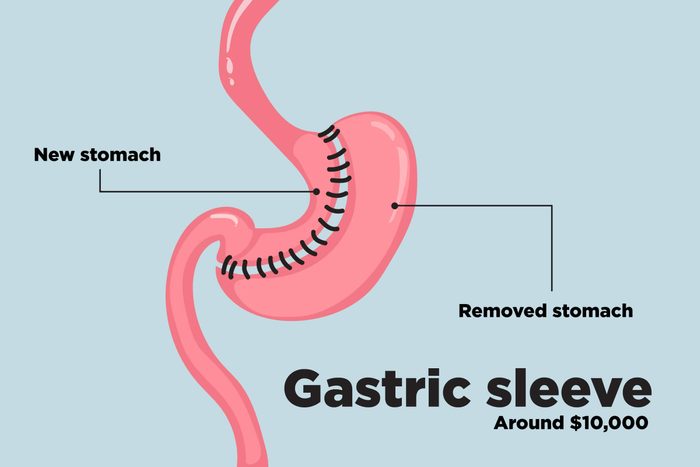
Gastric sleeve surgery
This is the most commonly performed weight loss surgery today largely because it’s the most effective with the lowest risk of complications, says Shawn Garber, MD, a bariatric surgeon in Roslyn Heights, NY and the founder of the New York Bariatric Group. Sleeve surgery accounted for more than 58 percent of total weight loss surgeries in 2016, up from just shy of 18 percent in 2011, according to American Society for Metabolic and Bariatric Surgery (ASMBS) data.
What’s involved? “We go in laparoscopically through five tiny incisions or a single incision in the belly button and cut out 70 to 80 percent of the stomach so that it looks like a sleeve,” says Dr. Garber. “You feel full quicker, and there are marked decreases in levels of ghrelin, also known as the hunger hormone,” he says. “My patients are simply not hungry and have to remind themselves to eat.”
Benefits: “You can lose up to 70 percent of your excess weight in a year,” Dr. Garber says. There are also improvements, if not reversals, in some of the conditions linked to obesity such as type 2 diabetes, high blood pressure, and sleep apnea. Still, “surgery is just a tool, not a cure.”
Cost: Around $10,000. Your insurer may cover some of the costs of sleeve surgery.
Some things to know about weight-loss procedures in general: If they involve surgery, they carry the typical risks of excessive bleeding, infection, blood clots, and a potentially bad reaction to anesthesia. Depending on the nature of the surgery, risks can include gallstones, hernia, and stomach perforation. And because the operations can block the absorption of certain foods and nutrients, you may need to take nutritional supplements.
To qualify for these procedures, you must have a body mass index (BMI) of 40 or greater, be roughly 100 pounds overweight, or have a BMI of at least 35 and one or more obesity-related issues, such as diabetes or high cholesterol. In case you’re wondering, here’s what you need to know about BMI.
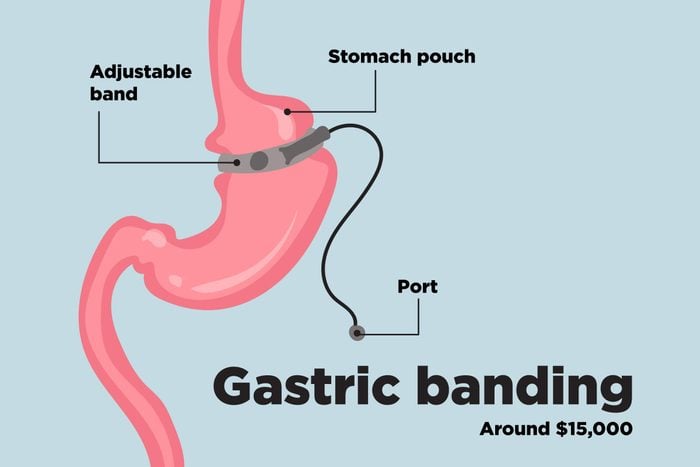
Gastric banding
Gastric banding or lap band surgery was the hottest weight loss procedure for years, but it has fallen out of favor. In 2011, bands represented 35.4 percent of all weight loss surgeries; in 2016, they made up just 3.4 percent, according to statistics from the ASBMS. “The lap band has gone the way of the Blackberry, says Mitchell Roslin, MD, FACS, FASMBS, the Chief of Obesity Surgery at Lenox Hill Hospital in New York City.
What’s involved? Your surgeon places a silicone band with an inflatable inner collar around your upper stomach to restrict how much you can eat.
Benefits: The band is reversible and adjustable with saline fills. You may lose up to two or three pounds a week in the first year after the surgery, but one pound a week is the average.
Cost: As high as $15,000. Many insurers will cover some of the costs.
Along with the usual risks, gastric banding presents another issue, says Dr. Garber: “The downside is that there is a foreign object in your body could that can slip, erode, or deflate.” Other risks include nausea, vomiting, and heartburn that occur when you overeat. “When you remove the band, patients can gain a ton of weight back,” Dr. Roslin says, and this has contributed to the demise of gastric banding.
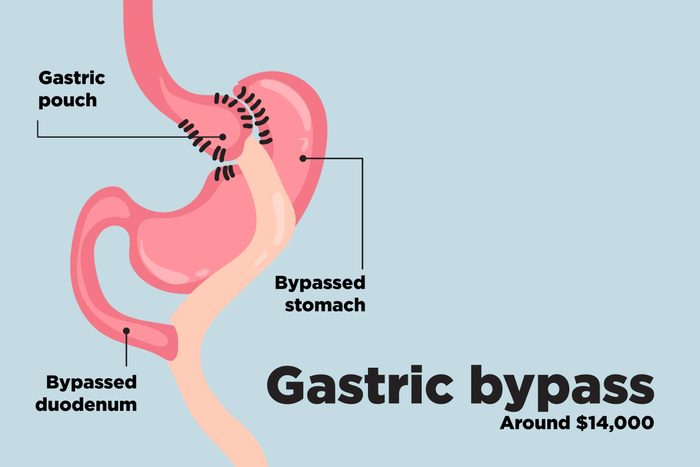
Gastric bypass
Gastric bypass was once the gold standard of weight loss surgery.
What’s involved? In simple terms, your surgeon staples a part of your stomach to curb food intake, and then re-routes a Y-shaped part of the small intestine so it attaches to the stomach pouch and food can bypass the duodenum (the first part of the small intestine). The Roux-en-Y bypass is most common form of gastric bypass surgery.
Benefits: You will lose 60 to 80 percent of your excess weight, the ASBMS states. One man’s journey after gastric bypass ranks as one of the most inspirational weight-loss transformations of 2017.
Cost: Averages around $14,000, with some insurers covering all or some of the associated costs.
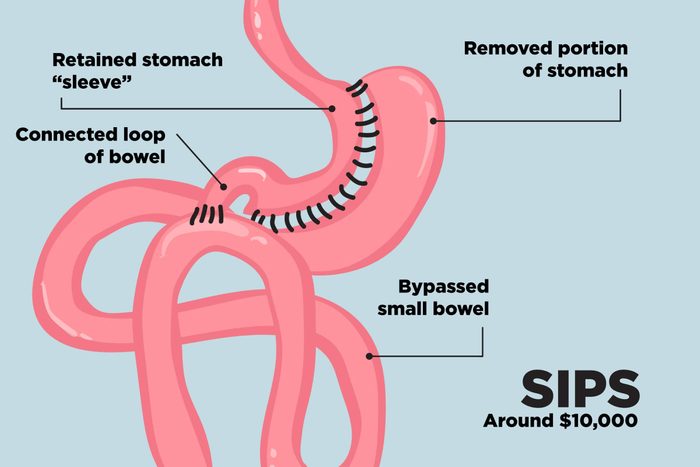
SIPS
Stomach intestinal pylorus-sparing surgery, or SIPS, is an up-and-comer, says Dr. Roslin who pioneered this procedure. It is a modified version of the duodenal switch weight-loss surgery.
What’s involved? SIPS involves the creation of a sleeve that is larger than the typical gastric sleeve with an attachment below the pyloric valve to control the emptying of the stomach into the mid gut.
Benefits: “It’s not as drastic as the sleeve surgery, yet weight loss is comparable,” he says. Preserving the pyloric valve prevents the rapid rise and fall of blood sugar. This valve controls the flow of partially digested food from the stomach to the small intestine.
Cost: Around $10,000. Some insurers will cover some of the costs of sleeve surgery.
Read these inspiring weight loss secrets from people who lost 50+ pounds—and kept it off.
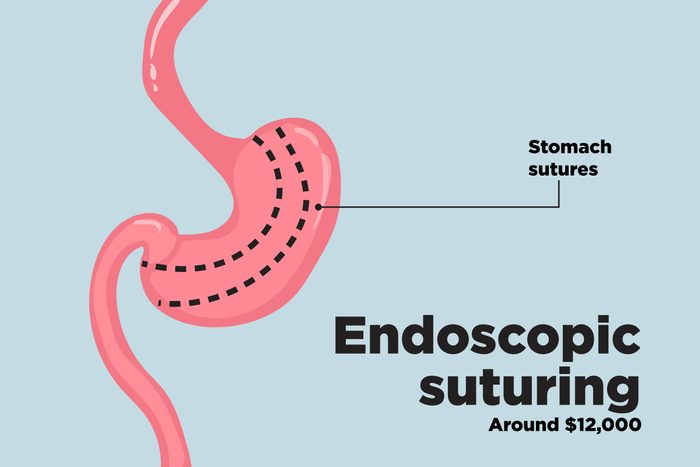
Endoscopic suturing
This is another new kid on the block, Dr. Roslin says.
What’s involved? Endoscopic sleeve gastroplasty is basically gastric sleeve surgery without surgery. During the procedure, a flexible tube with a camera and an endoscopic suturing device attached is inserted down your throat into your stomach. The tiny camera allows the doctor to see inside your stomach, and create the sleeve using sutures sans incisions.
Benefits: Studies show an average weight loss of 39 pounds after six months, with a weight loss of 42 pounds at a year. There are also significantly fewer complications and shorter hospital stays compared with gastric sleeve and gastric banding, according to research data presented at the scientific conference Digestive Disease Week 2017. Also, it may be available to people not heavy enough to qualify for other procedures: If your BMI is above 30 and you’ve been unable to lose using diet and other methods, endoscopic sleeve gastroplasty may be an option, Mayo researchers suggest.
Cost: $12,000. Given its newness, this weight loss surgery may not be covered by your health insurance.
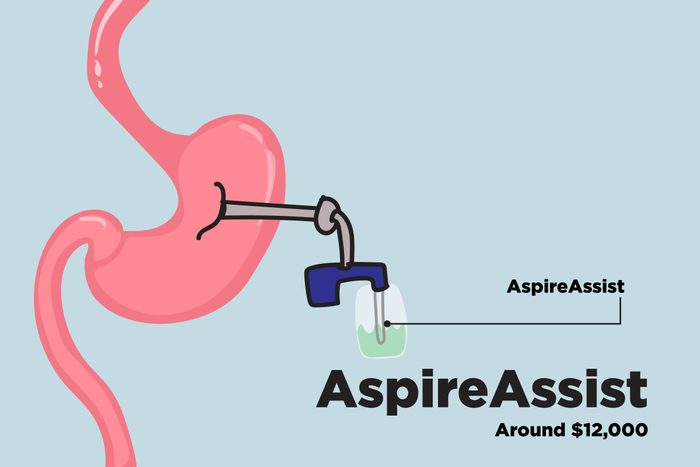
AspireAssist
What’s involved? The AspireAssist is a tube-like device that runs from inside your stomach to a valve on the outside of your abdomen. After each meal, you can empty—aspirate—up to 30 percent of your meal into the toilet through this tube by connecting a tiny handheld device to the button.
Benefits: “The data been pretty good, and it’s the only thing that holds a candle to the efficacy with bariatric surgery, but most people find this to be a non-starter,” Dr. Roslin says. The reality of dumping your stomach after every meal can be off-putting for many people.
Cost: Up to $12,000. Some insurers may cover some of the costs.
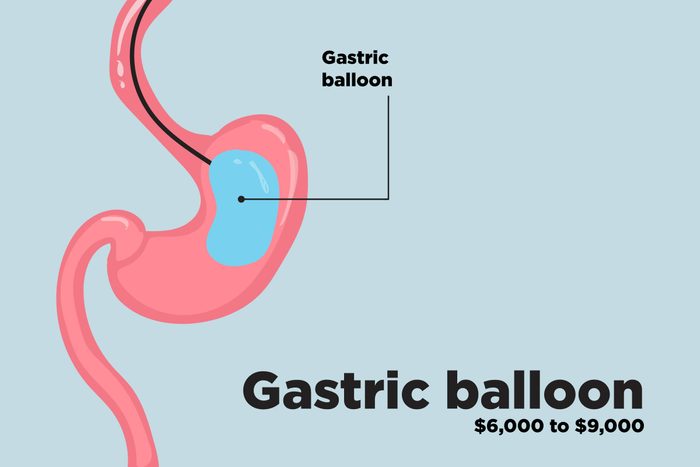
Gastric Balloon
Three are three gastric balloons available in the US today – the liquid-filled Orbera Intragastric Balloon System from Apollo Endo Surgery and the ReShape Integrated Dual Balloon System by ReShape Medical, and the Obalon system, which is gas-filled.
What’s involved? One or more balloons is placed into your stomach by swallowing or a minor procedure where they take up space in your stomach, reducing how much you can eat. They stay in place for up to six months. “You feel full quicker and learn portion control,” he says. “It’s a great jump start for a diet and is paired with nutritional counseling,” Dr. Garber says. Balloons stay in place for up to six months before they are removed. Expect regular follow-up throughout the process.
Benefits: “These are great options for people with a BMI of 30 to 40,” says Dr. Garber. “I’ve done about 750 of these, and patients lose an average of 36 to 90 pounds,” he says.
Cost: From $6,000 to $9,000. Insurance does not currently reimburse for the cost of gastric balloon.
